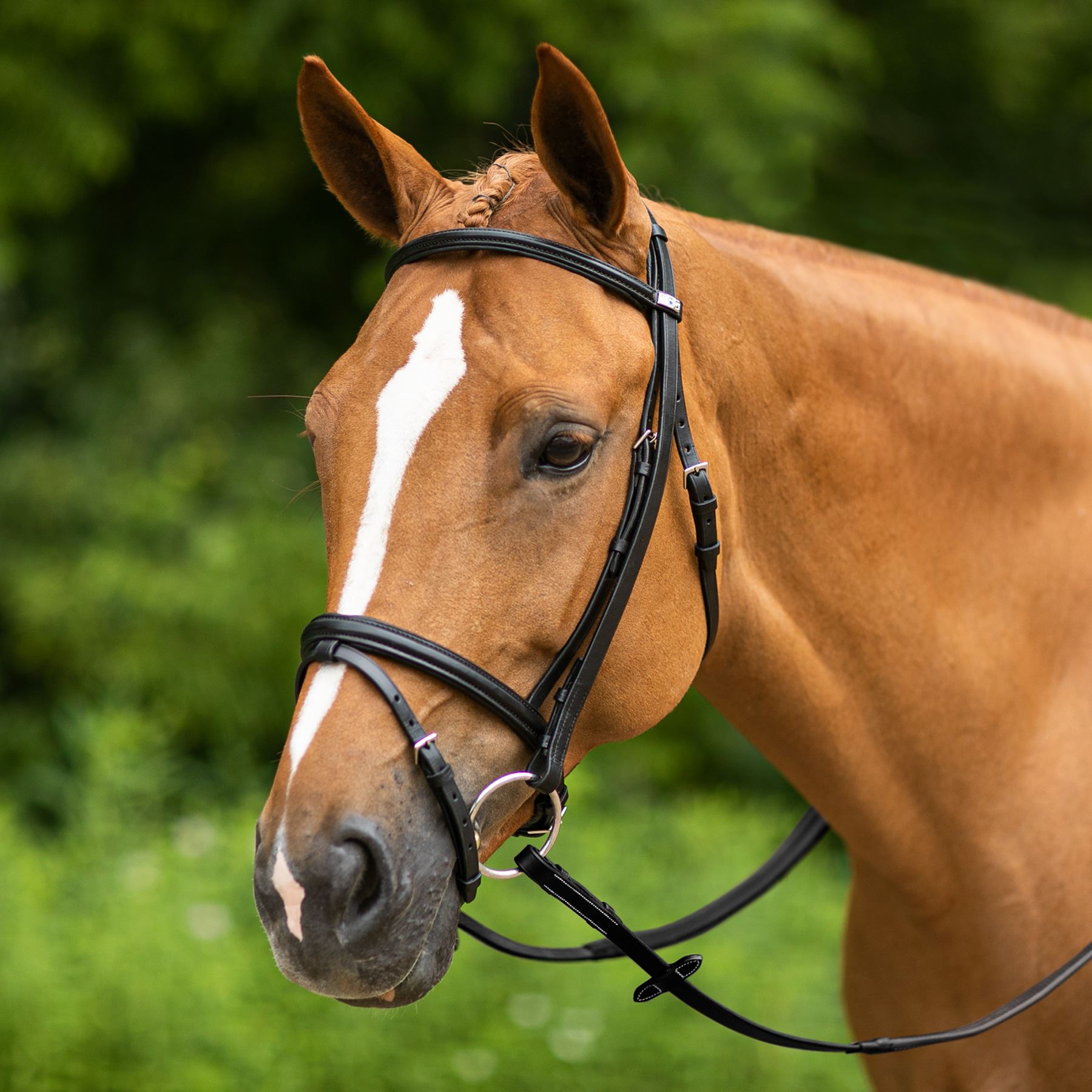Communication, Control, and Comfort
hh
Horse in a tight noseband
Three Horses, One Message
The black mare refused to go into the arena, backing up and shaking her head, as her rider encouraged her to go forward. Spurring the mare more intently, the mare eventually reared up. When I went over and suggested the rider loosen the “noseband,” the mare walked politely in the arena.
Lance was getting very strong with his dressage trainer, running off bucking and sometimes refusing to move forward. He was becoming dangerous, as he would also rear up and then take off bucking. Upon checking his new “crank noseband” the trainer had requested he be ridden in, it showed that sensitive pressure points were being constricted. Loosening the noseband to give Lance the ability to relax his jaw muscles, swallow his saliva, and move his tongue around almost instantly changed his behavior and he became a soft and relaxed horse.
Curtiss was a good jumper, but he liked to pull. He pulled so hard that the trainer continued to use stronger and stronger bits with tighter nosebands and even added draw reins. When I suggested we remove all the “restrictive devices” and try Curtiss in a soft three-piece snaffle with a loose noseband, the trainer objected saying he would run off. Curtis of course did just the opposite. He softened his jaw and gently started to relax the tension in his neck and jaw that had been caused trying to resist the tension the tight noseband and hard bits were causing him.
What do all these horses have in common? They were all trying to communicate discomfort. From double bridles with “crank nosebands” in dressage to figure eight and flash nosebands often used in jumping, restrictive nosebands can cause the horse to focus on the tension in his head, thus limiting his ability to focus on muscle movement in the rest of its body.
Expand
kt
Horse Welfare and Nosebands
While the use of “Rollkur” (the practice of hyperflexing “a horse’s neck achieved through aggressive force”) is banned by the F.E.I., the use of Rollkur is still very commonly seen at both dressage and jumper competitions, mostly due to trainer ignorance, rather then intent to “harm.” With a spotlight on horse-show welfare, several studies have recently been conducted that question and investigate whether the use of tight nosebands is humane or not.
Perhaps because it is easy for even an uneducated viewer to see a horse in pain through the look in its eye, the wrinkles in its brow, or the flared red nostrils struggling for air, or perhaps because academia is trying to wiggle its way into the world of sport horses – there is an increased awareness in the welfare of show horses, with the focus now being on nosebands.
One would think that there would be standards for “Best Management Practices” with horses, and all trainers would have the same knowledge and understanding of the equine anatomy, physiology, bio-mechanics, and how training devices affect horses. Nothing in the horse’s biology changes from discipline to discipline, even though humans use a variety of head-restraining devices on horses—all designed to control and communicate what a rider wants the horse to do.
Hearing trainers and judges maintain that the tighter nosebands “keeps the horse’s mouth closed and helps them listen to their hands,” might sound good, but usually does just the opposite. Resistance builds resistance. You can’t make a horse’s jaw muscles relax by tightening a noseband.
The horse is an emotional creature with millions of nerve endings running down the face to the nose and mouth all relating to smell, taste, chewing, touch, and vocalization. The horse’s world is built around sensory input to this portion of the limbic brain that is tied to emotions, learning, and memory. This nose and mouth is not at all related to the hind-end muscles, so the idea of creating engagement of the hind end through the mouth is a puzzling thought at best! Tight nosebands often restrict the function of these nerves causing the horse to stay focused on its head because of discomfort.
guesses what to do to relief pressure and discomfort and eventually learns how to avoid pain. Over time continued use, particularly of cranked nosebands can cause stress fractures in the teeth as well as damaged cartilage of the nose. For the intelligent rider there are far easier ways to communicate and train a horse.
A recent published study titled, “The Effect of Noseband Tightening on Horses’ Behavior, Eye Temperature, and Cardiac Responses”, by Fenner, Yoon, White, Starling, and McGreevey concluded that using double bridles with crank nosebands did indeed restrict normal physiological behaviors and increased stress in horses. One could argue that none of the horses were trained to be ridden in double bridles or wear snuggly-fitted nosebands prior to the study and so perhaps it did not accurately reflect good baseline data. However, there is no arguing the fact the study showed the potential for both physiological and psychological damage done to horses using double bridles and crank nosebands.
This could be confusing since a 2011 study published by H. Randle a researcher at Duchy College in Cornwall, U.K suggested that tightening nosebands by one hole reduces rein tension and causes the horses to be more sensitive to the bit to “maintain contact”. This study assumed bit contact was needed to communicate to the horse. Because only six geldings were used in the study and the same rider was used with a rein check device, no consideration was given to the training, gender, age or the fact the rider may not be sophisticated or aware enough to gain the attention and willingness of the horses ridden to listen to the riders communication.
Why Use a Noseband ?
Lets focus on the objective of the bridle, bit and noseband for a moment. If the purpose is to communicate with the horse, then it should make sense to have a comfortable conversation set up to allow a two way conversation between horse and rider. If the purpose is to control the horse, then as a rider you must ask yourself why you cannot communicate willingness in your horse to have a conversation and why your horse needs more control. Horses in general want to please and cooperate. Behavioral problems occur when humans do not listen or understand the horse’s attempt to communicate pain or worry. Tightening a noseband to give the rider more control rarely creates a happy willing partner. Give your horse the freedom to communicate using its mouth and when it is happy, it will have a quiet relaxed jaw and mouth. However, there are some horses who do actually seem to enjoy the bit with a correctly fitted noseband like a kid who needs to fold their hands and spit out the gum to quiet themselves.
A Western trained horse usually has no noseband if it has a bit and most seem to keep their mouths relaxed and closed. Using a hackamore or a boasl with no bit is also common for specific Western disciplines or even endurance. More options are now available for English horses too using bitless bridles and jumping hackamores. Bridles like the “Tota System” and Micklem promote communication and control with comfort by developing nosebands that limit sensitive areas on the nose. So there are many options in choosing how best to communicate with your horse.
Ask yourself, “Does your horse need a noseband or is it simply a fashion statement?”
Nosebands used appropriately and fitted properly can assist some horse and rider teams in training, but the focus should always be on the comfort of your horse not the tradition of your riding discipline.
Comfort Check
If you have decided to use a noseband for one reason or another, here is a simple check to conduct:
1. Educate yourself on the nerves, functions and anatomy of the horse’s head, face and nose. There are millions of nerve functions connecting to the emotions and learning in the horse. Not many related at all to the hind brain or muscle movement.
2.How sensitive is your horse around its nose and mouth ? Some horses do not like anything on their noses. This is more common with mares than geldings or stallions, but certain breeds and even bloodlines can be very sensitive to any form of touch on their noses. Highly sensitive horses do best with no nosebands or very loose ones.
3 Determine your horse’s conformation and type of noseband. Horses, like people all have different heads and noses. Some are long and narrow, some short and wide. Determine the best type of noseband to fit your horse’s nose shape and understand how it will affect the type of bit you may be using.
4. Can your horse yawn, stretch it’s jaw, swallow, lick its lips ? Regardless of the type of noseband you use, a correctly fitted noseband should allow your horse to be able to have full physiological movement. – check your horses muscle tension in the jaw muscles, poll and the TMJ. All these areas can become tense and locked up due to use of tight nosebands.
5. Listen to your horse – if you horse is refusing to go forward, shaking its head, racing through your hands, raising its head up, grinding its teeth, pulling on the reins, or doing any other odd behaviors, check your bit and particularly the tension and fitting of the noseband. Remember tension creates tension and so if you cause restriction, your horse will resist back.
The International Society for Equitation Science along with a number of other equine welfare organization made recommendations this year regarding tight nosebands. http://www.equitationscience.com/restrictive-nosebands. You can read their “Position Statement” and learn more about the recent studies.
In summary, if your discipline requires you use a noseband then be sure the noseband is enhancing the communication and comfort of your horse, not hindering it.
Expand
kt

